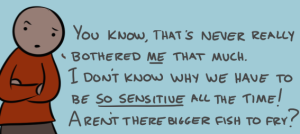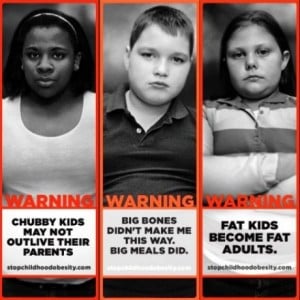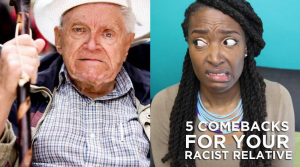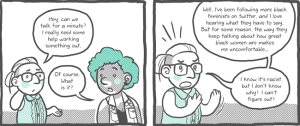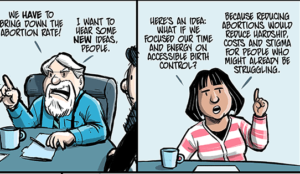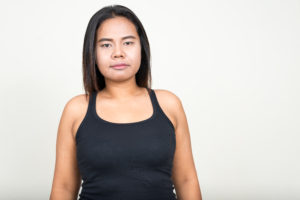
A person with a neutral expression and wearing a black tank top stands in front of a white background.
Originally published on The Body Is Not an Apology and cross-posted here with their permission.
(Content Warning: eating disorders)
For the past many years, I have struggled with an eating disorder. Searching for a therapist, I have called several locations.
Each time, they assumed, because of my voice, that I was a man and would want to be a part of their men’s services.
When I corrected and explained that I am not a man, they assumed I was a woman and would want treatment with other women.
My options always remained limited to my gender.
As my gender is neither male/man or female/woman, I felt myself lost as to how I could find care and help myself in ways that did not simultaneously erase my gender, especially as my experience as a gendered person affects my experience with an eating disorder.
And I am not alone in this.
Everyday Feminism has shared an article before about the disproportionate rate at which trans people experience eating disorders and the multitude of barriers that exist to seeking treatment.
Here are four more ways to begin thinking of eating disorders in relation to trans people – primarily non-binary trans people – and to work towards a de-gendering of these services, understandings, and institutions.
1. Expanding Gendered Explanations
On the National Eating Disorder Association (NEDA) webpage, they highlight that eating disorders are gender neutral, which they use to mean that eating disorders can affect any a/gender.
They, and many others, though, highlight the ways in which men and women require different treatments because of their gendered experiences.
Why, then, are the gendered realities of trans people not taken into account when developing programs to help individuals heal and recover?
Trans men are men and trans women are women, but their experiences probably will not be that of a cisgender man or woman.
Additionally, gendered violence is often enacted based on how you are perceived, not how you identify. So, for instance, I have experienced gendered violence based on people seeing me as a woman, a trans femme, a non-binary person, a cis gay man, and a femme man, and each of these separate layers and experiences has affected the development of my eating disorder.
Growing up in rural Utah, I assumed that since I wasn’t a boy, I must be a woman, as I didn’t have access to the multitude of webpages and resources that now exist about non-binary genders.
In finding myself in femininity that was attached to cis women, I learned that I had to be thin, small-framed, and dainty in order to truly be that which I saw myself as.
To be the tall kid with broad shoulders who was medically diagnosed with “obesity” at the time (which is inherently problematic in and of itself) meant that I would never match up to the femme in my cis women friends.
Simultaneously, as a then-gay boy, my straight friends indirectly taught me what it meant to be a successful gay boy, which was basically to be a twink or to be muscular. I consistently was asked, “Why are gay boys so attractive?” with the question never referencing me, but rather, the thin, hairless, masculine guys that are spread throughout gay media like termites.
Of course, this is just my experience. However, a quick search on the web pops up multiple stories of being non-binary and having an eating disorder and the differing reality that non-binary folks experience in the development of one, as well as recovery from it (like here).
Non-binary identities and realities challenge the idea of what it means to be masculine and/or feminine, in finding bits of both or neither that feel like their own femme or masc or androgyny or something else entirely.
In doing so, non-binary folks often experience gendered violence from multiple directions, depending on how they are perceived and read on any given day.
And as eating disorders can be symptoms of gendered violence, non-binary people experiencing multiple forms of gendered violence require different conversations, recovery processes, and understandings than the gender binary allows.
2. Feeling Undesirable as a Trans Person
As I found home in my non-binary femme identity and quickly lost access to jobs, housing, public accommodations, I felt a failure in every way possible: at being a gay boy, at being femme, and at being a human in general.
Dates and hookups became scarce unless I was being fetishized or fetishizing myself. I needed something to hold on to, to give me the ability to say I am desirable and worthy and lovable, setting the stage for my then disordered eating to morph into an eating disorder.
Trans people are rarely seen as desirable, even amongst themselves. A trans person often only becomes desirable to cis people when they themself pass as cis.
For some binary and non-binary people, there is no desire to pass, beyond the necessary need to do so at times to survive. Additionally, many trans folks simply cannot pass due to systemic barriers that prevent them from accessing surgeries that would allow them to look as they desire.
This inability or lack of desire to pass as cis challenges cisnormative ideas of what it means to beautiful.
But challenging what beauty means has never been an easy task. I can’t count the number of times I’ve been called a “monster,” an “it,” or ugly. I can, however, count the number of times I have been seen as desirable.
More often than not, those times were when my body weight was lower, as my femme was given more validity in those moments.
I think it’s easy to say that people like that aren’t worth our time or that we deserve better or that we find ourselves desirable and that’s enough. But reality doesn’t match that. It’s hard to feel undesirable. And often times, that feeling of being undesirable becomes the way in which we perceive ourselves.
Being trans doesn’t mean that I inherently dislike my body, but it does mean that others have worked to make me hate it.
3. Dysphoria
The monolithic trans narrative that we are told is that trans people are born in the wrong body and that they hate the body that they were trapped in.
This narrative often erases the countless experiences of binary and non-binary trans folks who never felt like they were born in the wrong body. Because this narrative is too often told, people, including doctors, come to believe it is true for all trans people.
I went to the doctor once hoping that she could help me manage my anxiety.
In the visit, she found out that I was trans and that I also had an eating disorder. She assumed that I hated my body because I was trans and not because of the eating disorder, and mentioned that I should begin seeing a therapist so I could navigate and figure out my identity and its relation to my body.
She tried to explain to me all the possibilities of surgeries and hormones and ways in which I could alter my body in order to love it. At the time, I worked at an LGBTQIA+ Resource Center and had already been doing community organizing work in which I had learned all the things she had said that she assumed I couldn’t possibly know.
But more importantly, she glossed over my explanation of hating my body and the fat on it that I saw as undesirable, and instead moved on to my “lack” of breasts and a vagina as the explanation.
She was half right – in that my transness did relate to my eating disorder and I needed a therapist who was trans-friendly and -competent.
However, I have never hated the ways in which my body developed through puberty. Instead, I have learned to hate the ways in which it stores food.
I have learned to see my not exercising in a given day as the doorway to immediately gaining weight in the next. I have learned to see my body not as something beautiful to nourish and take care of, but something to control and manage so as to ensure that it doesn’t get too “unwieldy.”
Gender dysphoria means that an individual either does not see their body as they want it to be or that society does not see it as they perceive it themselves – all of this in relation solely to their gender. Body dysmorphic disorder means that an individual perceives their body as the wrong shape, size, you name it. Sometimes these interact.
However, a trans person does not have to be experiencing gender dysphoria in order to have body dysphoria. A trans person does not always hate their genitals in addition to hating their body for not being thin or muscular enough.
Access to therapy needs to reflect this.
It is not enough to have therapists that help with recovering from an eating disorder and other therapists that help trans folks navigate transphobia and gender dysphoria. We need to have therapists that are able to acknowledge and validate the multitude of a/gendered experiences an individual may have had that led to an eating disorder without assuming false causes.
None of this is to say that eating disorder professionals need to ignore gender dysphoria. On the contrary, they need to remember it and think of it in the ways they seek to help folks who are currently struggling.
For people with gender dysphoria who cannot gain access to gender confirmation surgery, learning to love their body as it is can be nearly impossible (see #4 here).
The goal of eating disorder treatment needs to push beyond telling people there is nothing wrong with their bodies or that they merely need to love it as it is.
Instead, the question that should be asked is: How do we get to a place of loving ourselves while allowing room for us to want some things to change in ways that are safe for our bodies?
4. Ending the Binary of Perpetrator and Victim
In most social justice conversations, there is an assumed perpetrator and victim. Cis people are the perpetrators of cissexism and trans people the victims.
People with eating disorders are the victims to people who perpetuate transphobia, misogyny, racism, you name it. Women are the victims and men the perpetrators.
We desperately need to shift this conversation, though, to a recognition that we are all perpetrators of violence.
As a trans person, I have inflicted transphobia interpersonally with other trans folks. As a person with an eating disorder, I also recognize the multitude of ways in which I have continued to enact fat stigma.
What does it mean when I mentioned above that my eating disorder developed out of a need to feel desirable as a trans person, and the only way I could do that was to become thin?
It means that I have both internalized and perpetuated fat stigma.
When we see ourselves desirable only when we are thin, we might also begin to see others as desirable only when they are thin. It is not possible to map disgust onto my body because of the fat on it without my beginning to map it on all non-thin bodies.
Having an eating disorder is not an individual’s fault. It’s easy to say that because of that, it’s not my or anyone else’s fault when we, as people with eating disorders, see fat as an issue and something to hate.
But life is so much messier than that, and our intrapersonal thoughts often express themselves in our interpersonal relations.
It’s important that we create processes of recovery from eating disorders that not only allow us to navigate a safer relationship with our bodies, but which also challenge us to question what accountability looks like from us for our own interpersonal and systemic enactments of fat stigma.
To be honest, I’m not sure what that accountability is. At this point, it means recognizing my perpetuation of fat stigma, working from there to do, and remembering who paid the cost of me enacting fat stigma.
What I am asking for is not for us to begin catering to a small population that needs to have these conversations.
Rather, it is well past time that society, and everything/one within it, begins to recognize that the ways in which we have viewed gender and eating disorders have thus far been unable to hold all of the messiness that is oppression and humanity.
I hope we can move the conversation forward together.
***
If you are currently looking for resources that reflect trans and non-binary identities, check out Trans Folx Fighting Eating Disorders.
[do_widget id=’text-101′]
Alithia is a mentally ill, queer blobfish femme from rural Utah currently residing in Atlanta. Their pronouns are they/them/theirs.
Search our 3000+ articles!
Read our articles about:
Our online racial justice training
Used by hundreds of universities, non-profits, and businesses.
Click to learn more
Most Read Articles
- « Previous
- 1
- …
- 30
- 31
- 32








